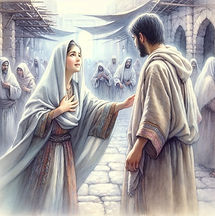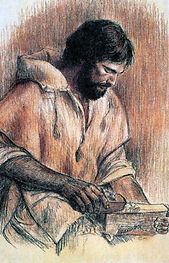

Third Sunday of Advent: Gaudete Sunday
"‘Let the earth be opened and bring forth a Saviour!’"

QR Code for Readings at Mass
By scanning this with your phone, you will be able to access each of the Mass Readings for today.
Advent, a time of waiting, of patience, is drawing to a close, and the readings reveal our excitement. The time to welcome our Saviour is drawing near.
In our First Reading we have the prophecy of Isaiah. Weary of the kings of Israel, Isaiah foretells the child who is to be born of a virgin and named ‘God with us’.
The Psalm speaks of the all-powerful God, who created the earth. Those who follow him will receive blessings from the One who comes to save us.
St Paul (Second Reading), proclaims Jesus, descended from David in the flesh, but Son of God in the power of the Spirit and the resurrection.
In the Gospel, we hear Isaiah’s prophecy again. It is through Joseph’s trust in God, and his obedience, that God’s plan is fulfilled with the birth of Jesus, Son of Mary, Son of God.
As Pilgrims of Hope, we rejoice in this season of hope and the coming of the Light of the World. As the Jubilee year draws to a close, we might consider how, despite the often tragic state of our world, we can still place our trust in Jesus Christ our Saviour.

A moment to reflect....
Behold, the virgin shall conceive and bear a son, and shall call his name Emmanuel. First Reading
Let the Lord enter; he is the king of glory. Psalm
Joseph, son of David, do not fear to take Mary as your wife, for that which is conceived in her is from the Holy Spirit. Gospel
Further Reflection
Gospel Matthew 1: 18–24
A Gospel for the Jews Matthew recounts the Messiah’s birth not by focusing on Mary and her ‘yes’ to God (as does Luke), but by focusing on Jesus himself. Matthew is a Jew, writing for Jews who have become followers of Jesus and are now coming under pressure to abandon their faith. He wants to encourage them by demonstrating that Jesus is truly the one who has come to fulfil the prophecies of the Old Testament.
The significance of names
‘Jesus’: The Greek for ‘Yahweh helps’, which was also interpreted as ‘Yahweh saves’. In first-century Judaism it represents the Hebrew name Joshua.
The ‘Angel of the Lord’: In the Old Testament this was a common designation for God in communication with a human being, sometimes in dreams.
‘Joseph, Son of David’: This is the name used by the angel when he tells Joseph that he need not fear to take Mary as his wife, since she has conceived by the Holy Spirit. It thus echoes the prophecy ‘Hear then, O house of David ...’ (Isaiah 7: 13, 14: this week’s First Reading).
Emmanuel, God-is-with-us: This is not an ordinary name, but a ‘throne name’: a name taken by rulers giving the theme of their reign. Matthew begins and ends his Gospel with this theme, recalling it in the last line when the risen Christ appears in Galilee: ‘And behold, I am with you always; yes, to the end of the age’ (Matthew 28: 20).
Jewish Law and tradition In Judea, betrothal included the right of co-habitation. In Jewish Law, if a girl could not show evidence of virginity, she could be stoned to death (Deuteronomy 22: 20). The Jews believed that the Holy Spirit was the one who brought God’s truth to men and women, and enabled them to recognise that truth when they saw it. They especially connected the Spirit of God with the work of creation. Joseph was familiar with all of these things and responded in faith. Divine intervention in the birth of God’s chosen was a tradition in Israel’s faith, as for example in the conception and births of Isaac, Jacob and Samuel (Genesis 18: 11–14, and 25: 21; also 1 Samuel 1: 4–20 ).
St. Joseph
St. Joseph is a major figure in Christianity, venerated as the husband of Mary, the mother of Jesus, and his legal, earthly father, known as the "Guardian of the Redeemer".
A descendant of King David, he was a carpenter who exemplified quiet strength, obedience, and trust in God, protecting the Holy Family.
He is seen as a model of faith, courage, and quiet service, showing how one can have a profound impact without needing many words.
St Joseph is Patron of the Universal Church, fathers, workers, immigrants, travellers, and the dying.

"The Carpenter" (c) Frances Hook
To aid our reflection on the Sunday readings each week we are reproducing, with permission, content from St. Bueno's Outreach. If you would like to know more about them or access their guided prayer resources, 'Prego', you can contact them via their website.

Father in heaven, may the faith you have given us in your son, Jesus Christ, our brother, and the flame of charity enkindled in our hearts by the Holy Spirit ,reawaken in us the blessed hope for the coming of your Kingdom.
May your grace transform us into tireless cultivators of the seeds of the Gospel. May those seeds transform from within both humanity and the whole cosmos in the sure expectation of a new heaven and a new earth, when, with the powers of Evil vanquished, your glory will shine eternally.
May the grace of the Jubilee reawaken in us, Pilgrims of Hope, a yearning for the treasures of heaven.
May that same grace spread the joy and peace of our Redeemer throughout the earth. To you our God, eternally blessed, be glory and praise for ever. Amen
Pope Francis, Jubilee Prayer